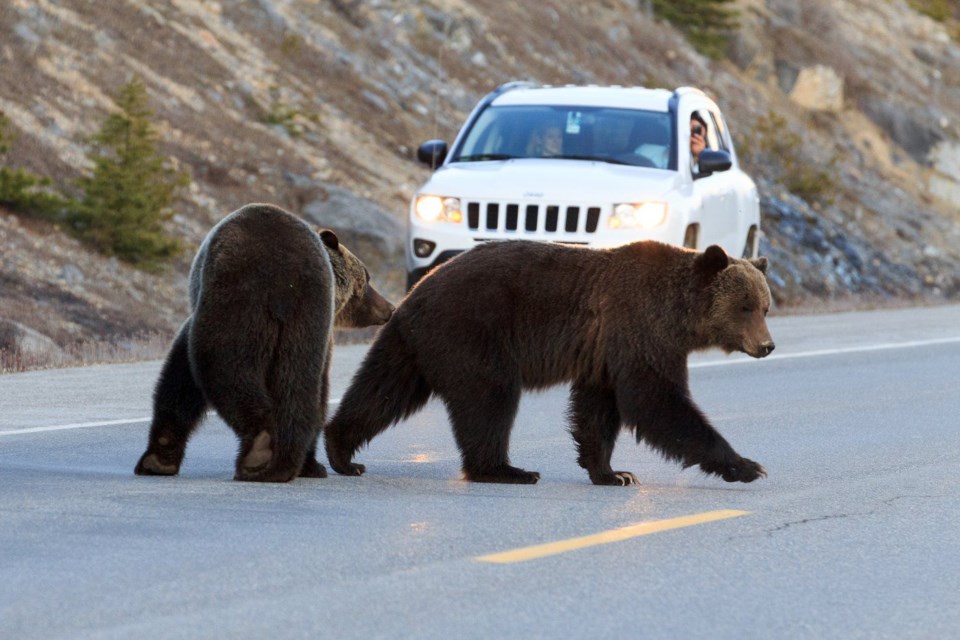Mike Gere’s thoughts on watching someone approach a roadside bear for a postcard-perfect photo may not make for family-friendly reading in a community newspaper.
“You want to be able to print this, right?” he asked.
The seasoned local professional photographer with Jasper Photo Tours likely has some choice words on the subject.
He has seen many people putting themselves in danger while causing disturbance to the wildlife involved, all in the interest of wildlife photography. He confirmed that he upholds strong ethics and follows the rules while being out regularly looking for another great shot.
“Give the wildlife room to be wildlife,” he said.
Parks Canada guidelines state that all people must keep a minimum of 30 metres away from elk, deer, moose and bighorn sheep, and 100 metres away from bears, cougars and wolves.
That distance goes up to 200 metres for coyote, fox or wolf dens.
Gere said that this is actually very easy. His tours never open the door until the van is back at home base.
“Wildlife is wild and can't be predicted,” he said. “It doesn't matter what it is: stay in the vehicle. Keep yourself safe. Keep the animals safe.”
National Parks Regulations state, “You are not allowed to entice, pet or attempt to pet, harass or feed wild animals in the park. Pursuing animals with cameras is considered harassment. Animal behaviour is unpredictable and could result in injury if they are not given enough space. Obstructing traffic is an offence and a hazard to other motorists. Pull over in designated pullouts only for viewing wildlife.”
Gere said that even designated pullouts can become a problem. He offered a standard scenario where there’s an animal by the side of the Icefields Parkway, and multiple cars are pulled over in the pullout lane on both sides. This makes drivers in motion stop on the road itself, creating a traffic jam.
And that’s when people start getting out of their vehicles.
“You've got a bit of a game of I don't know if you'd call it one-upmanship or leapfrog where someone says, ‘Oh, that person's closer so I can get closer,’” he said.
“Next thing you know, you've got a whole bunch of cars pulled over at the side of the road and a stack of people thinking that they can use the vehicles as cover or an island of safety and the amount of boldness just grows.”
Whenever there is a “wildlife jam,” Parks Canada staff will often use paintball guns or noisemakers to scare the animals away. Gere suggested they should “haze” the people instead.
“They're behaving badly, not the wildlife. The wildlife didn't do anything wrong. It's the humans that are the problem.”
Avoid boldness and just be smart, he explained, adding that everyone can keep their ethics intact by using a telephoto lens and exercising their patience.
One of the most dangerous cases of harassment that Gere has seen took place at Talbot Lake this spring. A bear was on a small piece of land surrounded by water, which was fenced off by the roadway.
A group of people started gathering around to get photos, cornering the bear with “almost a human wall,” getting closer and closer while the bear had no means of escape other than the water. It was apparent how stressed the bear had become.
Parks Canada managed to arrive and clear the situation in time.
Parks Canada’s website on wildlife photography has a list of five guidelines, the first of which is “Do not surround, crowd or follow an animal.” It also includes not enticing wildlife with noise or food, something that Gere has also witnessed.
“That's not good ethics either,” he said.
The website also includes some traffic guidelines and pertinent defensive signals to watch out for, indicating that the human should retreat and leave immediately.
Harassment of wildlife should be reported by calling Jasper Warden Office anytime at 780-852-6155 (or toll free 1-877-852-3100) and providing pertinent details.
Any violation can result in an eviction, arrest and a fine.



